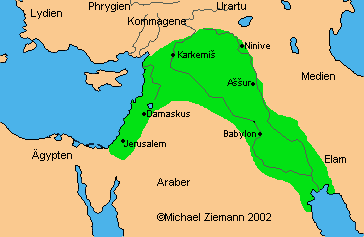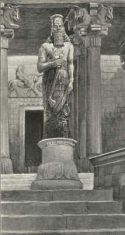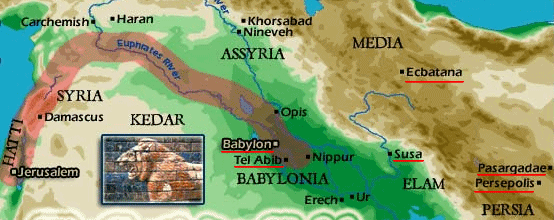from: Israel Finkelstein /
Neil A. Silberman: The Bible unearthed.
Archeology's New Vision of Ancient Israel and the Origin
of Its Sacred Texts; The Free Press, a division of Simon
& Schuster, Inc., 2001; German edition has got the
title "No trombones before Jericho" (orig. German:
"Keine Posaunen vor Jericho"): edition C.H.Beck oHG,
Munich 2002;
Here in this analysis is used the
German version "Keine Posaunen vor Jericho" of DTV,
Munich 2004, second edition of 2005. All page
indications refer to the German version. I hope the page
numbers are not very different.
The mini kingdom of "Judah"
is going down
Since the death of Josiah four more
kings are following accompanying the decline of the mini
kingdom of Judah (p.313).
Egypt's expansion in the Mid East
In the time after Josiah's death
Egypt has it's last heyday with severe wars against the
Mesopotamian Reichs and with territorial expansions up to
far in the Mid East. The Pharaohs mean that their dreams
would be fulfilled (p.313).
[The borderline of Euphrates river
always plays an important role here as always in the Mid
East].
608 B.C.
Mini Reich of Judah under king
Jehoahaz
King Jehoahaz seems to be
against Egypt (p.313).
OT claims:
-- king Jehoahaz is said having
permitted the "sinful" religious pluralism again
-- Pharaoh Neho II is said having
degraded king Jehoahaz after 3 months already and having
him banned (p.313).
608-598 B.C.
Mini kingdom of Judah under king
Jehoiakim
OT claims:
-- king Jehoiakim is said having gone on
with the "sinful" religious pluralism
-- king Jehoiakim is said having used
taxes of the own population for tribute payments for
Pharaoh Necho II (p.313).
since 608 B.C. appr.
Prophet Jeremiah going on with
propaganda against "foreign gods"
Jeremiah is said having deplored that
the number of the gods adhered in Judah corresponds
allegedly to the numbers of towns in Judah, and in
Jerusalem would be allegedly that many altars of Baal as
is the number of alleys (Jeremiah 11,13) (p.263).
605 B.C.
Babylon's rise under Nebuchadnezzar -
Egypt has to retread to the Nile river
The army of Babylon is winning a battle
in the town of Carchemish in Syria under the prince royal
which is known as Nebuchadnezzar later. The army of Egypt
has to retreat back to the Nile river (p.313).
[Again a big Empire is going down by an
overextension of it's borderlines, and also the Empire of
Nebuchadnezzar will collapse by another overextension of
borderlines...]
Now follow
destructive military campaigns under Nebuchadnezzar in
the Middle East
The victory in Carchemish is spelling
the doom for Assyria which is without help of Egypt now.
Nebuchadnezzar becomes the king of Babylonia and is
heading for a breakthrough to the Mediterranean [as other
Empires did before him]. Now destructive military
campaigns are following one after the other with the
destruction of the Philistine towns (p.314).
In Judah there is a great panic with the
discussion on which side one should stay. The government
under king Jehoiakim is calling Pharaoh Necho II for help,
and this action is taken by Babylonia as a pretext to
devastate Judah (p.314).
December 598 - March 597
Death of
king Jehoiakim - king Jeconiah follows
The Babylonian armies are at the border.
OT claims that Jerusalem had been sieged (p.314).
597 B.C.
The mini kingdom of Judah is said
having been devastated - and first "Babylonian
captivity" follows
OT claims:
-- Jerusalem had been conquered and
devastated by the Babylonian armies
-- the upper and middle class is said
having been deported
-- the royal court with king Jeconiah is
said having been deported to Babel, from the nobles 7,000,
from the craftsmen 1,000 persons (2d book of Kings
24,10-16) (p.314)
-- all in all it is said that 10,000
people had been banned (2d book of Kings 24,14) or 8,000
(2d book of Kings 24,16) (p.327).
The documents speak
In this case Babylonian
chronicle confirms the OT. Add to this Nebuchadnezzar
installs in Judah an own king, the uncle of Jeconiah,
Zedekiah (p.315).
The "1 god movement" with it's priests
is deported [and their influence seems to be banned at the
moment]. In Judah itself the population keeps split
(p.315).
596-586 B.C.
Kingdom of Judah: king Zedekiah is
trying a conspiracy against Babylonia
with other local kings (p.315).
[Addition
Nebuchadnezzar is not dependent
on the mini Reich of Judah. That's why this conspiracy of
king Zedekiah is a statal suicide from the first moment
on. The reasons are in the dark for that. Perhaps
Zedekiah's government meant that God will bring another
"miracle". Speculations may go on...]
 |
Map of Babylonia under Nebuchadnezzar II at
about 590 B.C. reaching from Persian Golf to
the Mediterranean Sea: The breakthrough has
succeeded, Babylonia is governing over the
whole "Fertile Crescent". But Nebuchadnezzar
wants more...
|
And now punitive expeditions are following:
?
Punitive expedition: Edom is
coming first - and also Edom gets a Babylonian captivity
-- in 6th century B.C. the kingdom of
Edom is destroyed by the troops of Nebuchadnezzar and is
depopulated (p.81)
-- only in the central Greek epoch this
region is populated again settling people (p.82).
587 B.C.
Punitive expeditions and destruction of
Jerusalem under Nebuchadnezzar with the elimination of
the town wall
According to Finkelstein / Silberman this military
campaign is "the beginning of the end" (p.315). The mini
kingdom of Judah - already minimized - has about 75,000
inhabitants according to the investigations and
excavations, of these are 15,000 in Jerusalem and another
15,000 around Jerusalem (p.328).

 Nebuchadnezzar, statue
Nebuchadnezzar, statue
|

 Invasion
under Nebuchadnezzar against Judah Invasion
under Nebuchadnezzar against Judah
|

Map of the Empire of Nebuchadnezzar |
Archeology can prove for this time that almost all Judean
towns in all regions of the kingdom have got a layer of
destruction which can be allocated to this destructive
military campaign. Osaka (clay tablets) in the
fortification of Arad for example describes the military
orders in an absolute danger and the transport of food
stocks etc. In Lachish there are messages on osakas how
one town after the other around Lachish is burnt down and
how the signals are extinguished, for example of the town
of Aseka (p.315).
According to Jeremiah 34,7 Lachish and Aseka are
performing the longest resistance. At the end only stays
Jerusalem that is sieged up to the destruction (p.315).
Nebuchadnezzar has also the surrounding kingdoms besieged.
The siege of Tyre for example is said having lasted for 10
years [web01].
OT claims:
-- in Jerusalem is said that hunger has broken out, and
the troops of Nebuchadnezzar are said having invaded
(p.316)
-- king Zedekiah is said having fled, having seized and
having blinded in Babel (2d book of Kings 25,3-7) (p.316)
-- one month later - under the leadership of Nebusaradan,
the supreme commander of the body guards of
Nebuchadnezzars, now as a military captain for whole
Jerusalem - is said having burnt down whole Jerusalem,
having torn down the whole town wall, and having deported
the rest of the population (2d book of Kings 25,8-11)
(p.316). There is no precise indication in the OT (p.327).
Second
Babylonian captivity - numbers of the deported
Jeremiah is indicating 4,600 deportees for the
deportations to Babylonia (p.327).
According to Finkelstein / Silberman the numbers of
deportees are not precise because in the time of ancient
Greece the number of deportees means the numbers of family
leaders (p.327). By this - according to Finkelstein /
Silberman - it's possible that the maximum is not only
4,600, but about 20,000 deportees are possible (p.328).
When there are admitted 75,000 inhabitants in whole mini
kingdom of Judah, from these 15,000 in Jerusalem and
another 15,000 around Jerusalem so there remain 45,000 in
the new province of Yehud (p.328).
Towns of the exile were Babylon, Tel Abib, Susa, Ecbatana,
Persepolis, and Pasargadae [web02].
 Map with the towns of the Babylonian
captivites: Babylon, Tel Abib, Susa, Ecbatana, Persepolis,
and Pasargadae
Map with the towns of the Babylonian
captivites: Babylon, Tel Abib, Susa, Ecbatana, Persepolis,
and Pasargadae
586 B.C. appr.
The town of Mizpah can
survive by peaceful handover - the flight of the prophet
Jeremiah to Mizpah
OT claims:
The territory of the northern region of Jerusalem with the
town of Mizpah is said having been handed over without any
violence (Jeremiah 37,12-13; 38,19) (p.328-329).
Archeology can confirm the handover of the territory of
Mizpah without violence. Excavations of the ruins of
Mizpah at the Tell en-Nasbe near Ramallah [?] under the
archaeologist Oded Lipshits from Tel Aviv university give
the result that Mizpah was not destroyed by the Babylonian
military campaign because a correspondent layer of
destruction is missing (p.329).
According to OT the town of Mizpah under governor Gedaliah
- the son of Ahikam - has become a refuge for other
Judeans, e.g. for the prophet Jeremiah, an enemy of the
rebellion (p.318).
OT claims a theory
of punishment by God against Judah
The Old Testament claims that God had
organized the self destruction of the temple which was
dedicated to him punishing the population of Israel for
its disloyalty. God is said having served himself with the
enemies of Judah and is said having been stronger than all
other gods (p.21).
Nos Israel is organizing itself as a
religious community and not as a state any more (p.21).
Archeology
confirms the destruction of Jerusalem
Archeology can confirm the last moments of
violence in Jerusalem, with arrowheads in the burnt-out
ruins (p.316):
-- the mini kingdom of Judah is destroyed
and ruined (p.316)
-- the total destruction of Jerusalem by a
fire storm can be proved for this time (p.328).
Now Judah becomes "Yehud"
The new Babylonian province is called
"Yehud" now and the inhabitants are called Yehudim, this is
the first time the population is called "Jews" (p.318).
The sons of the last kings of Zedekiah are
all killed (p.316).
[Addition: It seems that the far relatives
are not killed, because the line of David is emerging later
again].




 Nebuchadnezzar, statue
Nebuchadnezzar, statue

